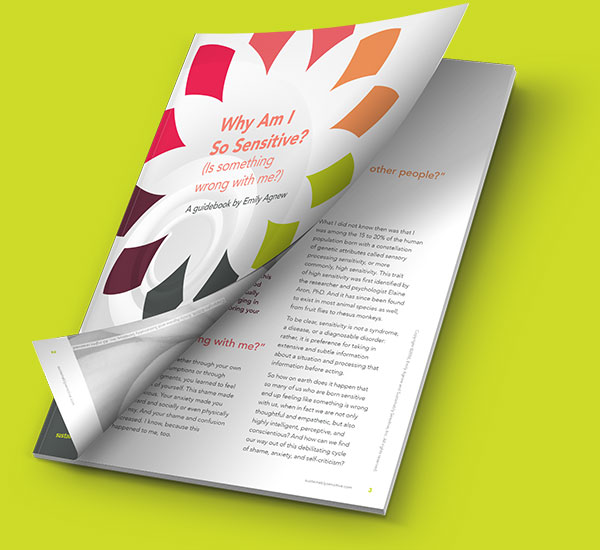Difficult as it sounds, you can learn how to be with despair. We need this skill now more than ever.
If you are highly sensitive, then you’ve likely experienced despair. I used to believe that if I evolved enough or did enough inner work or “got my s— together” once and for all (whatever that means) I’d never feel despair.
I don’t think that way anymore. When you feel as intensely as HSPs feel, care as deeply as we do, and are as conscientious as we are, it can hit you hard when things don’t turn out the way you’d hoped.
On the personal level, ending a relationship, losing a job, or letting go of a long-held dream can leave you feeling despair. And I don’t have to list the societal and environmental challenges we’re facing nationally and as citizens of the planet. There are good reasons to feel despair as you look around at our world today.
For some of us, though the sources of despair run deeper and more internally, connected to painful ways of coping we developed as kids. If you’ve attacked yourself internally to try to control yourself—to stop yourself doing things that upset people around you, or to make yourself do things to try to please them—then you will be vulnerable to despair.
Despair is hard to feel and perhaps even harder to talk about. It feels too intense, too personal, too revealing. Shameful, even. Yet if you develop the right inner relationship skills, you can hold and move through despair—whether it’s stimulated from the outside or the inside. First, you have to understand the nature of despair.
What is despair?
Despair is defined as the “total loss or absence of hope.” Hope, in turn, is “a feeling of expectation or desire for a certain thing to happen.” In other words, despair is the total loss or absence of any expectation and desire that a certain thing will happen.
There’s a lot to that. First, there’s the totality of it: that is, the “total loss or absence of any expectation and desire.” Despair implies and requires total surrender. When you are in despair, you’ve stopped fighting “what is.”
In addition to the totality of despair, there’s the loss of hope itself. This sounds terrible. In a way, it is. At the same time, it isn’t. Despair, like the ocean floor, is solid. It means you have hit on some kind of truth that lies at the very bottom. When a sinking ship finally hits the deep ocean floor, there’s a soft thud and a puff of sand…then utter silence and stillness.
Terrible as that silent darkness seems, it means the ship is no longer plunging. You are on solid ground now. In that sense, the rock-bottom quality of despair becomes the foundation of a new reality. From here, you could possibly go forward. Before, you could not.
From that solid ground, awful as it feels, you can find your way back up to the surface again. How exactly do you do this, though? Despair has a bad reputation for a very good reason: it is extremely hard to feel. In fact, we will do almost anything not to feel such hopelessness.
Instead, we go to our addictions of choice: drugs or alcohol, exercise or eating, compulsive talking or doom scrolling. An activity itself isn’t necessarily addictive. What matters is your intent as you do it—that is, the intent to protect yourself from feeling the pain of hopelessness.
How we learn to fear despair
Our fear of hopelessness typically starts early in life. Young children don’t have the same sense of time as adults. If they feel hopeless, it can feel as if they’ve always felt that way and always will, with no one there to help. If a child doesn’t get support to hold their intense feelings, they quickly learn to numb or repress them.
What is the upshot of all this? In order to spring back from despair, you must first address your fear of it. This can be tough to do if the “younger you” believes that you will be crushed if you allow yourself to experience despair in your body. Fortunately, you don’t have to dive in all at once. You can go slowly.
You will likely need support, too, if this is your first attempt to sit with despair. When you approach the despairing place in you with the company of an experienced practitioner, you give the “younger you” the experience you missed as a child: the opportunity to feel an intense feeling while being soothed and supported.
This is challenging work. You will need courage to find the willingness even to try to sit with a pain that feels, by its very nature, as if it can never change. However, if you can do this, you’ll realize that yes, it hurts—but it also passes. You can learn to stay regulated in the face of intense emotions like despair.
The numbness that results from trying to push the despair away, by contrast, is much worse. You’ve walled yourself off from all your feelings. You can soldier on, but at a price. With each step, you feel as if a trapdoor could open into the abyss.
Three parts of me, trying to cope
I’ve come to see despair as a kind of purifying fire. I don’t invite it, but if it comes, I know I have to pass through it in order to find my way forward. The key is to be with the despair, without being taken over by it.
How exactly do you do that? First, you need to sit with the part of you that believes you must have done something wrong in the first place, to have reached a place of despair. You haven’t. However, this part missed that memo. You need to establish a compassionate relationship with it before it will allow you to go deeper.
Next, underneath this outer layer of self-judgment and shame, you’ll find two more parts:
- Something in you that feels despair
- Something in you that is terrified of despair, so it tries not to feel it.
When I am merged or identified with a despairing part—that is, when it feels like the despair is all of me— I feel as if I am drowning in despair. This feels unbearable, so the second part steps in to give me relief. It works overtime to push away the despair. Eventually, though, the despairing one reasserts itself. I swing back and forth from one to the other, from numbness to despair.
The part that tries not to feel despair is trying to keep me alive and functional. Of course I need to function, but the price is high. I’m living in muted fear, like a person whose house stands right on the edge of a cliff. My “stay functional at all costs” part is sure I’ll be annihilated if I fall into the abyss of feeling.
What despair needs
What makes the despair truly unbearable is not the feeling itself. It is the loneliness and overwhelm of being all alone and “in the river” with the despair.
In other words, the one in you that feels despair needs company. Specifically, it needs respectful company. In fact, it demands it: your despairing part has no tolerance for being cheered up. No wonder: from its point of view, there truly is no hope. To connect with it and gain its trust, you must first respect its reality.
Your despairing one also needs radical acceptance. If I patronize my despairing part by suggesting it should be any way other than it is, I will send it into deeper despair. It needs to know I’m willing to let it be as it is for as long as it needs to be. This requires skill and support: if you are the least bit merged or identified with the part of you that fears despair, your despairing part will feel it.
The gift: pure Presence
Though I’ve somehow always known how to be with others’ despair, I’ve felt ashamed of my own. This became a vicious cycle in which I’d keep the feelings pent up until they burst out, which alarmed those around me even more and made it very difficult for them to be with me in an accepting way.
What changed? In my case, I learned Focusing. With Focusing, I developed the skills and awareness to hold all the parts I’ve described here: the one that feels despair, the one that is terrified of the despair, and the one that says I wouldn’t be feeling despair in the first place if I were “doing it right.”
Focusing has given me a reliable, powerful way to hold all these feelings and reactions in the container of radical acceptance that we call Self-in-Presence. To put this another way, focusing has transformed my ability to process the intense feelings that are a hallmark of my high sensitivity.
It takes time and practice to develop the skill to be with emotions as intense as despair, but the reward is high: a rare level of unconditional Presence. If you can be present with all this, what can faze you? For a highly sensitive person, it’s a gift beyond price to no longer be afraid of your own feelings.
As an example of how far you can go with this, here’s an inspiring article by one of my main Focusing teachers, Barbara McGavin. Barbara struggled for years with suicidal despair. In the process, she and Ann Weiser Cornell developed the skills of radical acceptance I’ve tried to describe here. Along the way, they created Inner Relationship Focusing—the principal modality I use with clients, along with Inner Bonding.
I send gratitude to Ann and Barbara. Their work is a gift to highly sensitive people everywhere.
Photo by Kaitlyn Wyenberg (kaity.wyenberg.gmail.com). Thank you so much Kaitlyn.
Note: This article originally appeared on February 22, 2016. It has been expanded from the original version.




















Great article Emily, It seems we feel it but don’t talk about it… I love the way you explain despair and what it might feel like.
“What makes the despair unbearable is not the feeling itself. It is the loneliness and overwhelm of being “in the river” with the despair. No one is there to hear its cry for help.”
And just being with it, accepting and allowing while making space for it.
Thanks again,
Deb
Excellent article. Ty!!
You are welcome Deb. Yes, “just” being with it. I say “just” because it isn’t always so easy….but it is what is needed.